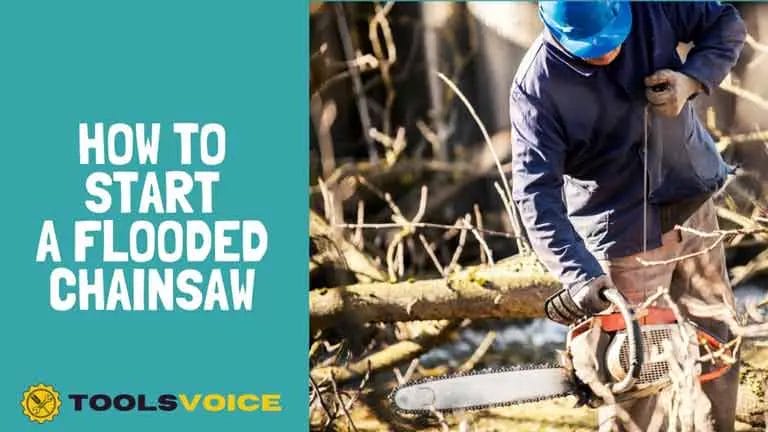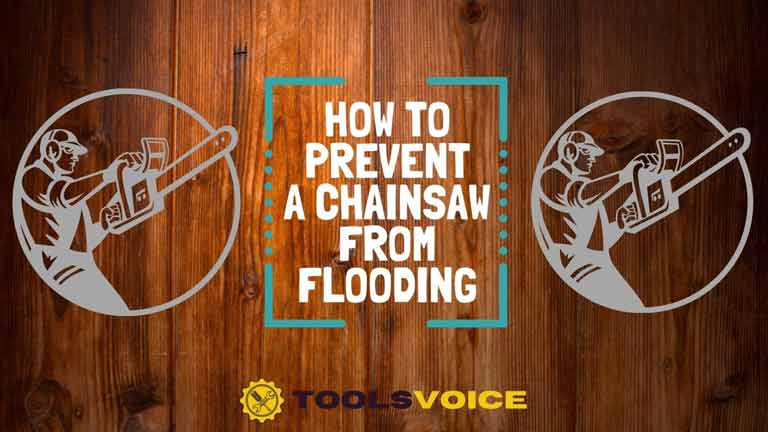If you’ve ever needed to use a chainsaw but couldn’t because it was flooded, then this article is for you! Chainsaws are not the easiest tool to work with, and if they’re not running properly, it can be even more difficult.
Luckily, there are several ways that you can unflood your chainsaw and make it possible to start again without having to take it apart or purchase any expensive tools.

How to Unflood a Chainsaw [Step-By-Step]
So, your chainsaw won’t start because of flooding? Well, there are many ways to fix your problem so that you can go back to cutting wood as soon as possible.
We create a step-by-step guide for you to make this easier. So, keep reading!
Step One:
Check the manufacturer instruction manual and follow safety instructions before beginning any work on your chain saw.
Step Two:
Find a clean, flat surface and place the chainsaw on it. Move the lever to lower the chain and remove the cover by flipping it open or using a screwdriver. Make sure you read your manual first for how to do this properly!
You may need to consult your user manual as they vary in design depending on the type of chainsaw.
Step Three:
Remove the top part of the engine cover and air filter.
Step Four:
Then you have to unplug the spark plug.
To minimize the risk of injury, remove any unnecessary clothing and slip gloves over your hands. Gently unplug the spark plug connector from the high voltage cap, making sure to keep a firm hold on it.
You need to act carefully, don’t pull with all your strength. Otherwise, it can be pulled off the wire.
Step Five:
Take the supplied wrench and unscrew the spark plug. Begin by tightening the wrench onto the end of the spark plug, then turning it counter-clockwise to loosen it.
When loose, finish unscrewing with your hand and take out the spark plug from the chainsaw engine. Now you can safely turn off any fuel supply – simply press the choke control lever.
Step Six:
After you take out the spark plug, take a look at it. It should be dry. If there is water on it, that means your chainsaw is flooded. So, you need to clean it and remove any excess fuel from the tip of the spark plug. For cleaning purposes – you can use a towel or paper napkin. If you have an air compressor available – it would be a good idea to blow air over the tip of the spark plug.
Step Seven:
Now, this is the most important step for unflooding a chainsaw.
Your chainsaw is not designed with flooded conditions in mind. But sometimes, it’s difficult to avoid an overfill fuel tank and clogged air filter when you are using your saw for long periods of time without stopping.
It can also happen if there was no gas cap on the fuel fill port or the gas was left in the tank for too long.
To unflood your saw before it becomes an expensive repair:
- Disconnect the spark plug wire, and remove any gas from the carburetor.
- Drain fuel tank and refill with fresh gasoline (keep in mind that ethanol absorbs water from the atmosphere). If you have a spare, then drain it as well to avoid any residual dirt or debris clogging up your saw’s carburetor later on.
- Remove debris blocking air filter/fuel line by accessing these areas through an inspection plate on top of the saw’s engine.
- After removing the air filter, put your thumb over the hole at the bottom of it, then turn on the saw. The pressure from turning it on will push some of the gas out through your thumb and withdraw the extra fuel
- Remove the spark plug and pull out the choke cable to ensure the engine isn’t flooded with gas or oil before trying to start it.
- Run the saw for a few minutes to remove excess fuel from the engine.
- Pump the primer bulb in and out of your chainsaw’s fuel tank to help loosen any dirt or debris that may remain within. This will also give you a chance to see what is inside. If there are still particles clogging it up, then you can take steps accordingly before restarting the saw.
As you can see, a chainsaw is an expensive tool to purchase and maintain. It’s important to learn how to use it properly the first time so that you don’t have any costly repairs or replacements in the future. The best piece of advice I could give you when buying your own saw is: if at all possible, buy a spare fuel tank.
What is a flooded chainsaw?
A flooded chainsaw is a chainsaw with an internal combustion engine that will not start when the fuel tank is full. This can be caused by too much fuel in the carburetor, a plugged air cleaner or restricted fuel passages from intrusion.
The solution to this problem is to siphon off the excess fuel until it is less than ½ full, replace the air cleaner or clean out any obstruction in the fuel passages.
How to Start a Flooded Chainsaw?
After unflooding the chainsaw, it’s pretty easy to start up and get back to work.

Make sure the choke is off and the chain brake is on. Then, start the chainsaw by pulling on its starter cord.
After you have done this, pull on the chain until you hear or see that it is moving smoothly without any jerks or pauses. That mean’s your chainsaw has been successfully un-flooded and should be ready for cutting.
However, if fuel continues to pour out from the intake tube, the saw should be turned off immediately and no longer used.
How to Prevent a Chainsaw from Flooding
It can be frustrating to work with a chainsaw that is constantly flooding. A chainsaw can flood for many reasons, but the most common reason is that the user does not know how to properly maintain it.
We are going to share some tips on how to prevent this from happening so you can get back to work fast!

Cleaning the Spark Plug
Check and Clean the Spark Plug- After each use, it is important to check that the spark plug is clean. If there are any loose pieces of debris in this area or if the oil has leaked into it then you will need to remove them before you continue using your chainsaw.
You can also submerge the entire thing in a container of water while you are cleaning it to make sure that the oil is not leaking into other areas.
Checking the Fuel Levels
Check your chainsaw Gas – If there is too much gas in the chain saw it could lead to flooding or clogging issues. Timely checking of fuel levels can help avoid this from happening.
Inspect The Oil Level- If you notice that there are too many bubbles in the oil, this could mean that there is an air leak somewhere on your saw and you’ll need to fix it before using it again.
Cleaning the Air Filter
Clean the Air Filter- The air filter needs to be cleaned and changed regularly. It is important for this part of your chainsaw to work efficiently in order to prevent flooding, so you will need to clean it when there is dirt or debris that may have accumulated on it during use.
Correctly Start your Chainsaw
Two-stroke Chainsaw engines can flood due to improper starting. Usually, the problem comes from novice chainsaw operators who are anxious when trying to start their stalled or flooded engine while it’s cold.
Before starting a chainsaw from a cold stop, you need to open the throttle, turn on the power switch and pull the starter cable. After pulling the starter cable four or five times, you will hear a ‘pop’. Then stop
To avoid flooding your chainsaw, make sure the throttle is off and pull the cord four or five times until it starts. If your chainsaw does not start, do the process again.
Store Your Saw Properly
If you don’t use your saw regularly, then you have to store it properly. Remove the gas and oil before storing to avoid flooding. When draining the oil, be sure not to spill any on the motor and for better result, store the chainsaw with its engine pointed upward.
One way to avoid getting your chainsaw wet is by removing the spark plug before storing it for the winter. Make sure your storage location is cool and dry, and replace any corroded or broken parts as soon as they show up.
Choose the Oil Carefully
Use the Right Oil – Your chainsaw will need to be oiled before and during each use, so make sure you are using the proper type of oil for your machine. If not, this could also lead to flooding or reduce performance in other areas.
Different chainsaws run on different types of fuel so be careful about which type you use or else there could be serious consequences such as a clogged engine or seizing piston rings in the cylinder.
Changing the Spark Plug
Check and Change Spark Plug- A spark plug will need to be changed on your chainsaw at least once a year and should be cleaned when you change it.
Proper Tensioning
Maintain Proper Chain Tension- A loose chain will be more likely to flood or break from excessive vibrations when cutting through wood, which is why it’s important to keep it tight for a healthy chainsaw!
Follow the Instructions
Read and Follow Instructions Carefully- Make sure that before using your new chainsaw for any task you read and follow all included instructions carefully and responsibly because if done poorly, it can result in serious injury or even death.
Cleaning the Sawdust
Clean Out The Sawdust- Leaving sawdust around will cause it to accumulate on various parts of the machine including vents that may not be able to handle extra heat dissipation as a result. This will also reduce the performance of your chainsaw when using it next time!
Some Additional Resources To Help You Learn More About Chainsaws:
Final Words
Unflooding a chainsaw is not a simple task. It requires proper care of the machine and follows all instructions before use. There are many different things to consider when it comes to maintaining your saw.
We try to cover everything about the unflooded chainsaws and hope that you liked the information we provided.
In the end, you should have a neatly organized chainsaw that is easy to clean and does not require as much maintenance from now on.